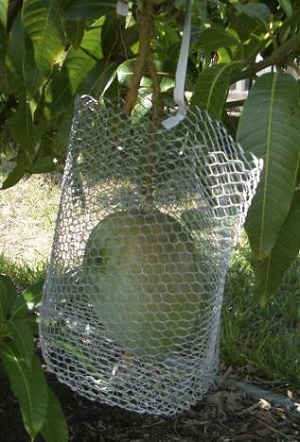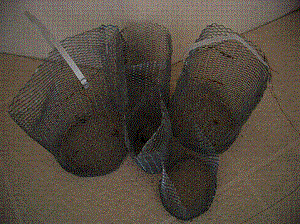Article for the Suncoast Tropical Fruit and Vegetable Club, Inc.
by Ed Lin
How to Protect Your Fruits and Nuts from Squirrels and Other Varmints
Recently, a fellow club member asked, “Is there any way
to prevent squirrels from eating all the nuts on a macadamia tree
before the nuts are mature?”
The answer is YES! All you
have to do is eat a few of the immature nuts yourself first. Or, get a
recipe for honey-roasted squirrels stuffed with macadamia nuts.

Seriously,
an excellent way to keep most, if not all, of the fruits and nuts you
grow from animals is to use a heavy-grade, fine-mesh wire cage to
"cage" the terminal branch along with the fruits/nuts. See
accompanying photos. This method is suitable for persimmons, mangos,
lychees, longans, atemoyas, etc. Before I describe how to create such a
system, I wish to acknowledge Ted Kapantais as the Ole Master for
showing me this versatile method. Thanks again, Ted.
Materials:
First, go to Home Depot and buy a sheet of stucco mesh ($7.99 for a
sheet 8 feet x 27 inches in the lumber section). If you do not have tin
snipes (sharp heavy grade “scissors” for cutting sheet
metal) you will need to borrow or buy one for under $10 at Big Lots.
Also get a spool of fine-gauge copper or steel wire which you will need
to “tie” the parts together. The galvanized wire mesh is
several mils thick with diamond shaped mesh that are about 1 cm X 1 cm
– too small and too tough for squirrel or raccoons to chew
through. It has very sharp edges and you can cut yourself if you
are not careful!
Method and Application:
Cut one rectangular piece and roll the short edges together into an
oval or round cylinder. Use wire to tie the short edges together. Next
cut a smaller rectangular or square piece and use that to fashion an
oval or round bottom. You will need a pair of pliers to bend the
“surplus” portions of the bottom portion so they conform to
the vertical wall of the cage. Tie the two parts together with wire and
now you have what looks like an oval- or round-bottomed wire-mesh
trashcan.
You will want to make a variety of sizes (refer to
photo) depending on how many different types of crops you intend to use
the cages on and the sizes of the fruits. For example, Keitt mango
(huge size), NDM Mango (large cluster) and longans (long panicles) will
call for large and deep cages, whereas persimmons and atemoyas will
tend to need smaller cages. Visualize how big the cages need to be with
the fruits inside, then make it a couple of inches deeper and longer.
You can always use a cage that is bigger than needed, but too small a
cage is worthless. After you have made your first cage, test it out on
a tree by feeding a terminal branch with the fruit into the mesh can.
Chances
are you will see how to modify your next cage for better fit. Then go
on and make more. You need to secure the cage to the branch with wire
or plastic strap. Copper wire is flexible and won't rust. Keep in mind
the pressure that can be exerted on the branch from being suspended by
thin wires. Try to diffuse the pressure wherever possible by using
multiple anchor sites between the cage and the branch. I prefer white
plastic shipping straps that I notch at the ends and they
“catch” easily enough in the mesh to suspend the cage. I
save these when I receive a large carton (TV, generator, carton of
paper, etc.) but you can probably also get them at the trash dumpster
of any department store.

Be sure to
“close” the mouth of the cage with wires or else the animal
can still try to get in from the top. The contraption works
beautifully. I make about two dozen of them of varying sizes (the large
ones for big bunches of fruits such as two or three mangos on one
panicle) and keep them on the ripest fruits. As I harvest the fruits, I
shift the mesh cans to the fruits next to ripen. The same cages
can be used on different trees that have different fruit ripening times.
Other Details:
If you make your cage by orienting the diamond mesh in the vertical
direction, you will get a cage that is very pliable and amenable
to changes in shape that you want in order to get the fit and closure
that you want for full protection. The slight disadvantage is that you
get a row of spikes along the mouth of the basket that can poke you
(poking the intruding animal in the face is an advantage). If you
orient the diamond mesh horizontally, you have a smooth-lipped basket
but it'll be very difficult to modify its shape. Overall, I
prefer the vertical orientation.
The cages are extremely durable and can last long enough to become a family heirloom.
Back To
Fruit General Page
How To Index Page
|
|

